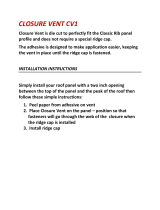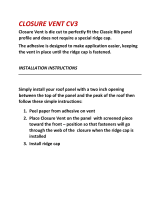
SM-Rib
4
Installation Information
Panel
There are three critical measurements involving roof
panels: the length required at the eave, the peak end
and the amount of panel lap (if required). In each
case a certain measurement is required. Check each
measurement to ensure panel placement gives you
the distance required at the eave, peak and endlap
condition (if required). In most cases any variance can
be taken out at the eave and peak.
Accessories
This publication details the standard line of trims and
accessories for SM-Rib roong and siding
applications. Additional trims, including custom
accessories, are available upon request.
Substrate
In residential applications, Southeastern Metals’
recommends the use of minimum 15/32 plywood
or 7/16 OSB decking. In addition, we specify a 30#
felt be installed in accordance with local building
code requirements to control condensation. NOTE:
Southeastern Metals does not recommend the use of
square headed cap nails. If tin tabs are used to secure
the 30# felt to the decking material, Southeastern
Metals’ recommends a separation sheet of 15# felt or
rosin paper be used over the 30# felt, applied in the
same direction as the panels. If the building param-
eters dier from those stated in the manufacturer’s
recommended fastening schedule, specic fastening
calculators must be computed by the engineer of
record.
Metal Re-Roong Over Shingles
Southeastern Metals’ metal roong panels may be
installed over existing asphalt shingles, provided the
roof decking integrity has been conrmed to be free
of any moisture decay that would prevent un-level-
ness or fastener pull out capacity. NOTE: Ordinances
regarding roong applications over existing shingles
vary by county and state. Check your local building
code organization for more information.
The panels may be applied directly over one layer of
existing shingles, provided a separation sheet is
installed on top to the shingles. We require a
minimum 30# felt installed in the same direction as
the panels.
Metal roong can also be separated from the moisture
barrier by optional 1” x 3” battens as furring, spaced a
maximum of 24” on center and fastened according to our
recommended application details. CAUTION: Direct con-
tact between pressure treated lumber and metal roong
must be avoided to prevent corrosion.
Metal Roong Fire Resistance Ratings
Southeastern Metals’ metal roong panels have been ana-
lyzed for re resistance ratings according to test criteria
set forth by Underwriters Laboratories “Standard Fire Tests
of Building Construction and Materials” (ANSI/UL 263), and
ASTM E119 and NFPA 251.
The re resistance rating is for the total assembly and not
just the external metal roong panels. In general, the test
criteria is to evaluate the assemblies ability to continue to
support the imposed loads and to resist the passage of
ame, high temperature, or hot gasses which will ignite
combustible sub-assembly, framing, or decking materials
from an exterior source. For detail information on specic
assembly ratings see the UL Fire Resistance Directory.
Attaining a class “A” or “B” re rating requires the
installation of one of the following - a minimum ¼” thick
Georgia Pacic “Dens Deck”; a minimum 4mm thick Partek
Insulation’s, Inc. “Roctex”; a minimum 52 ½# Elks “Versa
Shield”; a minimum 5/8” water resistant type X gypsum
sheeting with treated core and facer; or any other product
with a current product approval - over the combustible
deck prior to installing the metal roong panels.
Trimming and Cutting Steel Panels
Whether cutting with the prole (length-wise) or across
the panel (width wise), it is best to use an electric nibbler,
shears or hand tin-snips. It is very important to cut panels
one at a time with the nish side of the panel facing down
on wood blocks. Care should be taken to ensure that the
hot metal particles and lings from cutting and securing
the panel do not become embedded in the panel.
CAUTION: Filings from screw and panel cuttings must
be cleaned o the panel after screws have been applied
through the panel to avoid rust marks or “bleeding” on
the panels. Failure to comply with the above procedures
relieves Southeastern Metals, and its parent company,
Gibraltar Industries, of responsibility for any resulting
damage to, or deterioration of the nish and voids any
paint or nish warranty.






















